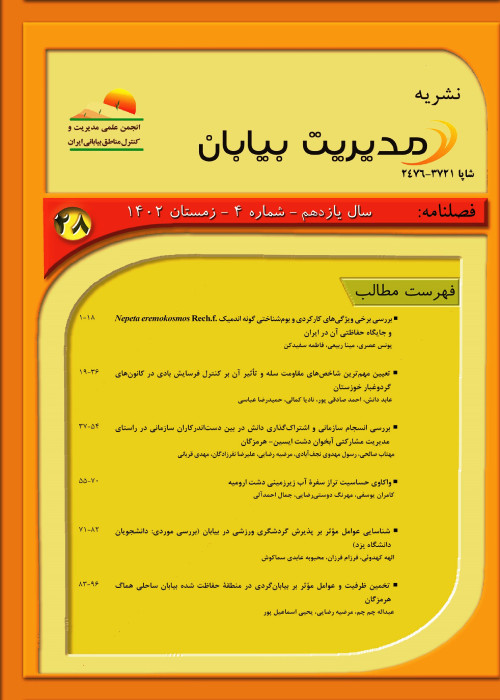The Effects of Nebkhas on Soil Infiltration and Evaluation of Some Infiltration Equations in Desert Conditions (Case Study: Ephedra strobilacea and Tamarix ramosissima Species
Author(s):
Abstract:
In recent years, the idea of nebkhas as a degradation index changed to signs of adaption and stability in desert conditions. Plants growth condition is very restricted in desert biomes, but nebkhas ecologically provide a better condition for some plants to grow. Nebkhas also change physical and chemical properties of the soil and also water balance conditions. In this study infiltration rate was compared between nebkhas formed by Ephedra strobilacea and Tamarix ramosissima and soil between nebkhas in Abarkouh area located in Yazd province. In addition, there are many hydrological models that use Green-Ampt or Horton equations for forecasting surface runoff. So this study also evaluated the efficiency of Green-Ampt or Horton equations. At the first, the locations of each nebkhas were recognized and soil of nebkhas and the soil between nebkhas were sampled. Soil samples were then delivered to the laboratory and main physico-chemical characteristics of all samples were measured. Infiltration rate was measured by double ring between nebkhas (bare) and in the nebkhas of the two species. Horton and Green-Ampt constants were also calculated. Infiltration models efficiency were analyzed by calculation of Nash-Sutcliffe coefficient and RMSE-Standard Deviation of Observation (RSR). Final permeability was measured at about 24 cm/hr for Ephedra strobilacea and Tamarix ramosissima nebkhas. Final permeability for between nebkhas (bare) of Tamarix ramosissima and Ephedra strobilacea were measured 3.6 and 7 cm/hr, respectively. Final permeability for Ephedra strobilacea and Tamarix ramosissima nebkhas was 6.7 and 3.4 times more than between nebkhas. It is concluded that nebkha play an important role in water infiltration and water resources in desert areas. Nash Sutcliffe ranges showed Green-Ampt and Horton models are in acceptable levels of performance for predicting infiltration rate of Tamarix ramosissima and Ephedra strobilacea nebkhas. However, the models show less accuracy for soil between nebkhas (bare), because of soil stratifying. The cause of these differences is that Aeolian materials of nebkhas sorted by wind show homogenous texture compared with the layered soil of between nebkhas. Horton and Green -Ampt models assumptions have conformity with homogenous soils.
Keywords:
Language:
Persian
Published:
Desert Management, Volume:1 Issue: 1, 2013
Page:
51
https://magiran.com/p1360513
دانلود و مطالعه متن این مقاله با یکی از روشهای زیر امکان پذیر است:
اشتراک شخصی
با عضویت و پرداخت آنلاین حق اشتراک یکساله به مبلغ 1,390,000ريال میتوانید 70 عنوان مطلب دانلود کنید!
اشتراک سازمانی
به کتابخانه دانشگاه یا محل کار خود پیشنهاد کنید تا اشتراک سازمانی این پایگاه را برای دسترسی نامحدود همه کاربران به متن مطالب تهیه نمایند!
توجه!
- حق عضویت دریافتی صرف حمایت از نشریات عضو و نگهداری، تکمیل و توسعه مگیران میشود.
- پرداخت حق اشتراک و دانلود مقالات اجازه بازنشر آن در سایر رسانههای چاپی و دیجیتال را به کاربر نمیدهد.
In order to view content subscription is required
Personal subscription
Subscribe magiran.com for 70 € euros via PayPal and download 70 articles during a year.
Organization subscription
Please contact us to subscribe your university or library for unlimited access!


